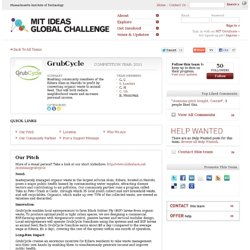

About The Project. Food security is a global challenge.
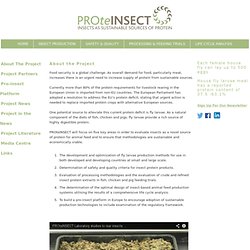
As overall demand for food, particularly meat, increases there is an urgent need to increase supply of protein from sustainable sources. Currently more than 80% of the protein requirements for livestock rearing in the European Union is imported from non-EU countries. The European Parliament has adopted a resolution to address the EU’s protein deficit, stating that urgent action is needed to replace imported protein crops with alternative European sources. One potential source to alleviate this current protein deficit is fly larvae. As a natural component of the diets of fish, chicken and pigs, fly larvae provide a rich source of highly digestible protein.
'mini-livestock' in Entomophagy: Edible Insects and the Future of Food. Protein Alternatives: Insects as Mini-Livestock. Www.proteinsect.eu/fileadmin/user_upload/deliverables/D5.1t-FINAL.pdf. Water.epa.gov/polwaste/upload/FarmWeek-May21.pdf. Www.maz.ch/arbeiten/deza/Messmer/VT_2013_041_20_Insects.pdf. Foris.fao.org/preview/31654-08b9c12f60eda84d122b1ad454c381bb4.pdf. Four legs good, six legs better? EU offers 3 million Euros for research into using insects in foods such as burgers.
By Rob Waugh Updated: 12:42 GMT, 30 January 2012 A Thai guide eats a grub: Around 2.5 billion people worldwide eat insects The EU will spend three million Euros to research 'the potential of insects as an alternative source of protein.' Research projects will be selected this year.
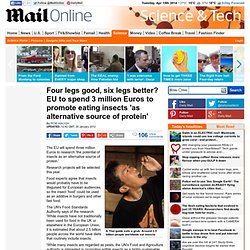
Food experts agree that insects would probably have to be disguised for European audiences, so the insect 'food' could be used as an additive in burgers and other fast food. The UN's Food Standards Authority says of the research: 'While insects have not traditionally been used for food in the UK or elsewhere in the European Union, it is estimated that about 2.5 billion people across the world have diets that routinely include insects. 'While many insects are regarded as pests, the UN's Food and Agriculture authority is interested in promoting edible insects as a highly sustainable source of nutrition.'
The Benefits of Eating Insects. Www.food-insects.com/Insects as Human Food.htm. Processed insects are commercially available in Japan (Mitsuhashi, 1984; Kantha, 1988).
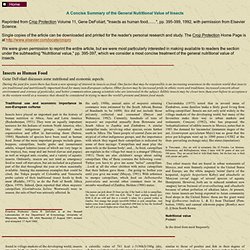
The most widely eaten is inago (the grasshopper, Oxya velox F.), which is preserved by boiling in soy sauce. This product appears as a luxury item in supermarkets through- out the country, including Tokyo. Mitsuhashi (1984) states (translation): 'Catching inago is an activity that adds poetic charm to rice paddies in autumn'. He further describes an inago hunt at an elementary school in Tsukuba Science City in Ibaraki Prefecture, in which the fathers and mothers who participated collected 68 kg of inago in 2 h. Mitsuhashi suggests that with rice in overproduction, why not let inago feed on the excess, thus increasing the population of the grasshopper. Magazines, and the subject is usually treated more seriously than in the past.
References Ashiru, M. 0. (1988) The food value of the larvae of Anaphe venata Butler (Lepidoptera: Notodontidae). Www.bio.unipd.it/agroecology/download/pdf/papers/2005/Minilivestock, Environment, Sustainability.pdf. Insectos comestibles son importante fuente de proteínas. Del total de especies de insectos que se consumen en el mundo, 527 forman parte de la dieta en 36 países de África, 29 en Asia y 23 en América.

Entre los insectos más consumidos figuran los escarabajos, saltamontes, grillos, hormigas, abejas y mariposas, según un informe de la agencia de Naciones Unidas. Esta práctica es conocida como entomofagia y se remonta a la época prehispánica en el continente americano, donde también se les ha utilizado con fines medicinales. No obstante, comer insectos en la dieta es algo poco usual en la civilización occidental, excepto en algunos países como México, con una fuerte tradición en el consumo de insectos. Aunque a muchos les causa repulsión el sólo pensar en comer insectos, hay paises y lugares donde encuentran mayor aceptación y forman parte de la dieta cotidiana, especialmente en las áreas rurales. Insectos, las tapas más nutritivas en Tailandia. En los últimos años, su degustación se ha vuelto muy popular en Bangkok, adonde fueron introducidos por las familias que emigraban del medio rural.

"Los insectos son perfectos como aperitivo para acompañar con una cerveza o un vaso de whisky, aunque también hay gente que los toma con arroz", señaló a Efe Sakorn Boonduang, quien se dedica a vender estas pequeñas delicias en un mercado de la capital. Los precios oscilan entre los 150 bat (unos cuatro dólares o tres euros) por el kilo de escarabajos enanos a los 300 bat por el kilo de hormigas. Preparados a la parrilla adquieren una textura crujiente y ahumada y se ingieren salpimentados, con pepinillos o bien unas guindillas.
Empresa brasileña pretende producir insectos para el consumo humano. Además de la autorización del Gobierno brasileño, el fundador de la empresa, Luiz Otavio Possas, reconoció en declaraciones concedidas a la edición en internet del diario Folha de Sao Paulo que existen "barreras culturales" que deben ser superadas para conquistar el mercado en los países de occidente.
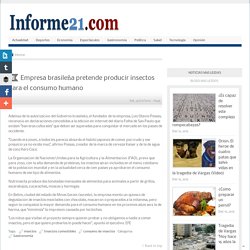
INBio enseña cómo cultivar insectos comestibles. Tomado de www.nacion.com Especialistas de Bután y Benén se encuentran en el paés capacitándose Costa Rica se beneficia conociendo las ventajas de comer estos animales.
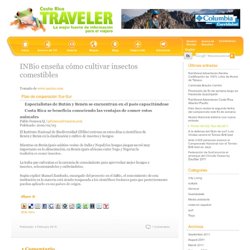
Www.fao.org/docrep/018/i3253e/i3253e.pdf. Wageningen UR - Wageningen University - Laboratory of Entomology. Beastly bugs or edible delicacies. 19 February 2008, Chiang Mai, Thailand - With over 1 400 insect species eaten by humans worldwide, the insect world offers promising possibilities both commercially and nutritionally, FAO said today.

A workshop organized by FAO this week will discuss the potential for developing insects in the Asia and Pacific region. While the idea of eating insects may seem unusual or even unappetizing to some, human consumption of insects is actually very common in most parts of the world. At least 527 different insects are eaten across 36 countries in Africa, while insects are also eaten in 29 countries in Asia and 23 in the Americas. Source of protein, vitamins and minerals Of the hundreds of insect species reportedly eaten as human food, the most common come from four main insect groups: beetles; ants, bees and wasps; grasshoppers and crickets; and moths and butterflies. University of Kentucky Entomology: Mystery Bugs. What is it about North American culture that keeps us from using one of our most abundant and readily available food sources, insects?
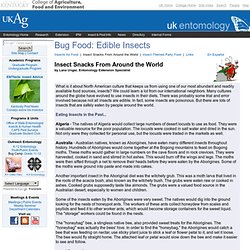
We could learn a lot from our international neighbors. Many cultures around the globe have evolved to use insects in their diets. There was probably some trial and error involved because not all insects are edible. In fact, some insects are poisonous. But there are lots of insects that are safely eaten by people around the world. Eating Insects in the Past... Algeria - The natives of Algeria would collect large numbers of desert locusts to use as food. Australia - Australian natives, known as Aborigines, have eaten many different insects throughout history. Another important insect in the Aboriginal diet was the witchety grub. Some of the insects eaten by the Aborigines were very sweet. The "honeybag" bee, a stingless native bee, also provided sweet treats for the Aborigines. MIT IDEAS Global Challenge. Competition Year: 2011 Summary Enabling community members of the Kibera slum in Nairobi to profit by converting organic waste to animal feed.
